- Home
- Ursula K. Le Guin
Changing Planes
Changing Planes Read online
Table of Contents
Title Page
Table of Contents
Frontispiece
Copyright
Author’s Note
Sita Dulip's Method
Porridge on Islac
The Silence of the Asonu
Feeling at Home with the Hennebet
The Ire of the Veksi
Seasons of the Ansarac
Social Dreaming of the Frin
The Royals of Hegn
Woeful Tales from Mahigul
Great Joy
Wake Island
The Nna Mmoy Language
The Building
The Fliers of Gy
The Island of the Immortals
Confusions of Uñi
About the Author and Illustrator
This is a work of fiction. Names, characters, places, and incidents either are the product of the author’s imagination or are used fictitiously, and any resemblance to actual persons, living or dead, business establishments, events, or locales is entirely coincidental.
Copyright © 2003 by Ursula K. Le Guin.
“The Silence of the Asonu” first appeared in Orion as “The Wisdom of the Asonu.” Copyright © 1998 by Ursula K. Le Guin. “Seasons of the Ansarac” first appeared on www.infinitematrix.net. Copyright © 2002 by Ursula K. Le Guin. “The Royals of Hegn” first appeared in Asimov’s Science Fiction. Copyright © 1999 by Ursula K. Le Guin. “The Building” first appeared in Redshift. Copyright © 2002 by Ursula K. Le Guin. “The Fliers of Gy” first appeared on www.scifi.com. Copyright © 2000 by Ursula K. Le Guin. “The Island of the Immortals” first appeared in Amazing Stories. Copyright © 1998 by Ursula K. Le Guin.
Illustrations copyright © 2003 by Eric Beddows.
All rights reserved.
No part of this book may be reproduced, scanned, or distributed in any printed or electronic form without permission. Please do not participate in or encourage electronic piracy of copyrighted materials in violation of the author’s rights. Purchase only authorized editions.
For information about permission to reproduce selections from this book, write to Permissions, Houghton Mifflin Harcourt Publishing Company, 215 Park Avenue South, New York, New York 10003.
www.hmhco.com
The Library of Congress has cataloged the print edition as follows:
Le Guin, Ursula K., 1929–
Changing planes / Ursula K. Le Guin ; illustrations by Eric Beddows.—Ace trade pbk. ed.
p. cm.
ISBN 0-441-01156-X
1. Fantasy fiction, American. 2. Imaginary societies. 3. Voyages, Imaginary. I. Title.
PS3562.E42C48 2004
813'.54—dc22
2004046109
eISBN 978-0-544-34168-5
v1.0314
Author’s Note
This book was written when the miseries of air travel seemed to be entirely the doing of the corporations that ran the airports and the airlines, without any help from bigots with beards in caves. Spoofing the whole thing was easy. They were mere discomforts, after all. Things have changed, but the principle on which Sita Dulip’s Method is founded remains valid. Error, fear, and suffering are the mothers of invention. The constrained body knows and values the freedom of the mind.
Sita Dulip's Method
The range of the airplane—a few thousand miles, the other Sita Dulip’s Method side of the world, coconut palms, glaciers, the poles, the Poles, a lama, a llama, etc.—is pitifully limited compared to the vast extent and variety of experience provided, to those who know how to use it, by the airport.
Airplanes are cramped, jammed, hectic, noisy, germy, alarming, and boring, and they serve unusually nasty food at utterly unreasonable intervals. Airports, though larger, share the crowding, vile air, noise, and relentless tension, while their food is often even nastier, consisting entirely of fried lumps of something; and the places one has to eat it in are suicidally depressing. On the airplane, everyone is locked into a seat with a belt and can move only during very short periods when they are allowed to stand in line waiting to empty their bladders until, just before they reach the toilet cubicle, a nagging loudspeaker harries them back to belted immobility. In the airport, luggage-laden people rush hither and yon through endless corridors, like souls to each of whom the devil has furnished a different, inaccurate map of the escape route from hell. These rushing people are watched by people who sit in plastic seats bolted to the floor and who might just as well be bolted to the seats. So far, then, the airport and the airplane are equal, in the way that the bottom of one septic tank is equal, all in all, to the bottom of the next septic tank.
If both you and your plane are on time, the airport is merely a diffuse, short, miserable prelude to the intense, long, miserable plane trip. But what if there’s five hours between your arrival and your connecting flight, or your plane is late arriving and you’ve missed your connection, or the connecting flight is late, or the staff of another airline are striking for a wage-benefit package and the government has not yet ordered out the National Guard to control this threat to international capitalism so your airline staff is trying to handle twice as many people as usual, or there are tornadoes or thunderstorms or blizzards or little important bits of the plane missing or any of the thousand other reasons (never under any circumstances the fault of the airlines, and rarely explained at the time) why those who go places on airplanes sit and sit and sit and sit in airports, not going anywhere?
In this, probably its true aspect, the airport is not a prelude to travel, not a place of transition: it is a stop. A blockage. A constipation. The airport is where you can’t go anywhere else. A nonplace in which time does not pass and there is no hope of any meaningful existence. A terminus: the end. The airport offers nothing to any human being except access to the interval between planes.
It was Sita Dulip of Cincinnati who first realised this, and so discovered the interplanar technique most of us now use.
Her connecting flight from Chicago to Denver had been delayed by some unspeakable, or at any rate untold, malfunction of the airplane. It was listed as departing at 1:10, two hours late. At 1:55, it was listed as departing at 3:00. It was then taken off the departures list. There was no one at the gate to answer questions. The lines at the desks were eight miles long, only slightly shorter than the lines at the toilets. Sita Dulip had eaten a nasty lunch standing up at a dirty plastic counter, since the few tables were all occupied by wretched, whimpering children with savagely punitive parents, or by huge, hairy youths wearing shorts, tank tops, and rubber thongs. She had long ago read the editorials in the local newspaper, which advocated using the education budget to build more prisons and applauded the recent tax break for citizens whose income surpassed that of Rumania. The airport bookstores did not sell books, only bestsellers, which Sita Dulip cannot read without risking a severe systemic reaction. She had been sitting for over an hour on a blue plastic chair with metal tubes for legs bolted to the floor in a row of people sitting in blue plastic chairs with metal tubes for legs bolted to the floor facing a row of people sitting in blue plastic chairs with metal tubes for legs bolted to the floor, when (as she later said), “It came to me.”
She had discovered that, by a mere kind of twist and a slipping bend, easier to do than to describe, she could go anywhere—be anywhere—because she was already between planes.
She found herself in Strupsirts, that easily accessible and picturesque though somewhat three-dimensional region of waterspouts and volcanoes, still a favorite with beginning interplanary travelers. In her inexperience she was nervous about missing her flight and stayed only an hour or two before returning to the airport. She saw at once that, on this plane, her absence had taken practically no time at all.<
br />
Delighted, she slipped off again and found herself in Djeyo. She spent two nights at a small hotel run by the Interplanary Agency, with a balcony overlooking the amber Sea of Somue. She went for long walks on the beach, swam in the chill, buoyant, golden water—“like swimming in brandy and soda,” she said—and got acquainted with some pleasant visitors from other planes. The small and inoffensive natives of Djeyo, who take no interest in anyone else and never come down to the ground, squatted high in the crowns of the alm-palms, bargaining, gossiping, and singing soft, quick love songs to one another. When she reluctantly returned to the airport to check up, nine or ten minutes had passed. Her flight was soon called.
She flew to Denver to her younger sister’s wedding. On the flight home she missed her connection at Chicago and spent a week on Choom, where she has often returned since. Her job with an advertising agency involves a good deal of air travel, and by now she speaks Choomwot like a native.
Sita taught several friends, of whom I am happy to be one, how to change planes. And so the technique, the method, has gradually spread out from Cincinnati. Others on our plane may well have discovered it for themselves, since it appears that a good many people now practice it, not always intentionally. One meets them here and there.
While staying with the Asonu I met a man from the Candensian plane, which is very much like ours, only more of it consists of Toronto. He told me that in order to change planes all a Candensian has to do is eat two dill pickles, tighten his belt, sit upright in a hard chair with his back not touching the back, and breathe ten times a minute for about ten minutes. This is enviably easy, compared to our technique. We (I mean people from the plane I occupy when not traveling) seem unable to change planes except at airports.
The Interplanary Agency long ago established that a specific combination of tense misery, indigestion, and boredom is the essential facilitator of interplanary travel; but most people, from most planes, don’t have to suffer the way we do.
The following reports and descriptions of other planes, given me by friends or written from notes I made on my own excursions and in libraries of various kinds, may induce the reader to try interplanary travel; or if not, they may at least help to pass an hour in an airport.
Porridge on Islac
It must be admitted that the method invented by Sita Dulip is not entirely reliable. You sometimes find yourself on a plane that isn’t the one you meant to go to. If whenever you travel you carry with you a copy of Roman’s Handy Planary Guide, you can read up on wherever it is you get to when you get there, though Roman is not always reliable either. But the Encyclopedia Planaria, in forty-four volumes, is not portable, and after all, what is entirely reliable unless it’s dead?
I arrived on Islac unintentionally, when I was inexperienced, before I had learned to tuck Roman into my suitcase. The Interplanary Hotel there did have a set of the Encyclopedia, but it was at the bindery, because, they said, the bears had eaten the glue in the bindings and the books had all come to pieces. I thought they must have rather odd bears on Islac, but did not like to ask about them. I looked around the halls and my room carefully in case any bears were lurking. It was a beautiful hotel and the hosts were pleasant, so I decided to take my luck as it came and spend a day or two on Islac. I got to looking over the books in the bookcase in my room and trying out the built-in legemat, and had quite forgotten about bears, when something scuttled behind a bookend.
I moved the bookend and glimpsed the scuttler. It was dark and furry but had a long, thin tail of some kind, almost like wire. It was six or eight inches long not counting the tail. I didn’t much like sharing my room with it, but I hate complaining to strangers—you can only complain satisfactorily to people you know really well—so I moved the heavy bookend over the hole in the wall the creature had disappeared into, and went down to dinner.
The hotel served family style, all the guests at one long table. They were a friendly lot from several different planes. We were able to converse in pairs using our translatomats, though general conversation overloaded the circuits. My left-hand neighbor, a rosy lady from a plane she called Ahyes, said she and her husband came to Islac quite often. I asked her if she knew anything about the bears here.
“Yes,” she said, smiling and nodding. “They’re quite harmless. But what little pests they are! Spoiling books, and licking envelopes, and snuggling in the bed!”
“Snuggling in the bed?”
“Yes, yes. They were pets, you see.”
Her husband leaned forward to talk to me around her. He was a rosy gentleman. “Teddy bears,” he said in English, smiling. “Yes.”
“Teddy bears?”
“Yes, yes,” he said, and then had to resort to his own language—“teddy bears are little animal pets for children, isn’t that right?”
“But they’re not live animals.”
He looked dismayed. “Dead animals?”
“No—stuffed animals—toys—”
“Yes, yes. Toys, pets,” he said, smiling and nodding.
He wanted to talk about his visit to my plane; he had been to San Francisco and liked it very much, and we talked about earthquakes instead of teddy bears. He had found a 5.6 earthquake “a very charming experience, very enjoyable,” and he and his wife and I laughed a great deal as he told about it. They were certainly a nice couple, with a positive outlook.
When I went back to my room I shoved my suitcase up against the bookend that blocked the hole in the wall, and lay in bed hoping that the teddy bears did not have a back door.
Nothing snuggled into the bed with me that night. I woke very early, being jet-lagged by flying from London to Chicago, where my westbound flight had been delayed, allowing me this vacation. It was a lovely warm morning, the sun just rising. I got up and went out to take the air and see the city of Slas on the Islac plane.
It might have been a big city on my plane, nothing exotic to my eye, except the buildings were more mixed in style and in size than ours. That is, we put the big imposing buildings at the center and on the nice streets, and the small humble ones in the neighborhoods or barrios or slums or shantytowns. In this residential quarter of Slas, big houses were all jumbled up together with tiny cottages, some of them hardly bigger than hutches. When I went the other direction, downtown, I found the same wild variation of scale in the office buildings. A massive old four-story granite block towered over a ten-story building ten feet wide, with floors only five or six feet apart—a doll’s skyscraper. By then, however, enough Islai were out and about that the buildings didn’t puzzle me as much as the people did.
They were amazingly various in size, in color, in shape. A woman who must have been eight feet tall swept past me, literally: she was a street sweeper, busily and gracefully clearing the sidewalk of dust. She had what I took to be a spare broom or duster, a great spray of feathers, tucked into her waistband in back like an ostrich’s tail. Next came a businessman striding along, hooked up to the computer network via a plug in his ear, a mouthpiece, and the left frame of his spectacles, talking away as he studied the market report. He came up about to my waist. Four young men passed on the other side of the street; there was nothing odd about them except that they all looked exactly alike. Then came a child trotting to school with his little backpack. He trotted on all fours, neatly, his hands in leather mitts or boots that protected them from the pavement; he was pale, with small eyes, and a snout, but he was adorable.
A sidewalk café had just opened up beside a park downtown. Though ignorant of what the Islai ate for breakfast, I was ravenous, ready to dare anything edible. I held out my translatomat to the waitress, a worn-looking woman of forty or so with nothing unusual about her, to my eye, but the beauty of her thick, yellow, fancifully braided hair. “Please tell me what a foreigner eats for breakfast,” I said.
She laughed, then smiled a beautiful, kind smile, and said, via the translatomat, “Well, you have to tell me that. We eat cledif, or fruit with cledif.”
“
Fruit with cledif, please,” I said, and presently she brought me a plate of delicious-looking fruits and a large bowl of pale yellow gruel, smooth, about as thick as very heavy cream, lukewarm. It sounds ghastly, but it was delicious—mild but subtle, lightly filling and slightly stimulating, like café au lait. She waited to see if I liked it. “I’m sorry, I didn’t think to ask if you were a carnivore,” she said. “Carnivores have raw cullis for breakfast, or cledif with offal.”
“This is fine,” I said.
Nobody else was in the place, and she had taken a liking to me, as I had to her. “May I ask where you come from?” she asked, and so we got to talking. Her name was Ai Li A Le. I soon realised she was not only an intelligent person but a highly educated one. She had a degree in plant pathology—but was lucky, she said, to have a job as a waitress. “Since the Ban,” she said, shrugging. When she saw that I didn’t know what the Ban was, she was about to tell me; but several customers were sitting down now, a great bull of a man at one table, two mousy girls at another, and she had to go wait on them.
“I wish we could go on talking,” I said, and she said, with her kind smile, “Well, if you come back at sixteen, I can sit and talk with you.”
“I will,” I said, and I did. After wandering around the park and the city I went back to the hotel for lunch and a nap, then took the monorail back downtown. I never saw such a variety of people as were in that car—all shapes, sizes, colors, degrees of hairiness, furriness, featheriness (the street sweeper’s tail had indeed been a tail) and, I thought, looking at one long, greenish youth, even leafiness. Surely those were fronds over his ears? He was whispering to himself as the warm wind swept through the car from the open windows.
The only thing the Islai seemed to have in common, unfortunately, was poverty. The city certainly had been prosperous once, not very long ago. The monorail was a snazzy bit of engineering, but it was showing wear and tear. The surviving old buildings—which were on a scale I found familiar—were grand but run-down, and crowded by the more recent giant’s houses and doll’s houses and buildings like stables or mews or rabbit hutches—a terrible hodgepodge, all of it cheaply built, rickety-looking, shabby. The Islai themselves were shabby, when they weren’t downright ragged. Some of the furrier and featherier ones were clothed only by their fur and feathers. The green boy wore a modesty apron, but his rough trunk and limbs were bare. This was a country in deep, hard economic trouble.

 Catwings
Catwings Tehanu
Tehanu The Tombs of Atuan
The Tombs of Atuan A Wizard of Earthsea
A Wizard of Earthsea The Other Wind
The Other Wind Ursula K. Le Guin
Ursula K. Le Guin Dangerous People
Dangerous People Worlds of Exile and Illusion: Rocannon's World, Planet of Exile, City of Illusions
Worlds of Exile and Illusion: Rocannon's World, Planet of Exile, City of Illusions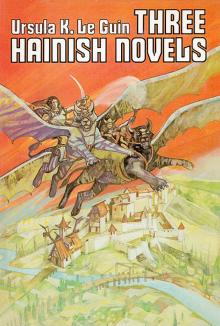 Three Hainish Novels
Three Hainish Novels The Left Hand Of Darkness (SF Masterworks)
The Left Hand Of Darkness (SF Masterworks) The Unreal and the Real - Vol 1 - Where On Earth
The Unreal and the Real - Vol 1 - Where On Earth The Visionary
The Visionary The Ones Who Walk Away from Omelas
The Ones Who Walk Away from Omelas The Word for World is Forest
The Word for World is Forest Always Coming Home
Always Coming Home The Unreal and the Real - Vol 2 - Outer Space, Inner Lands
The Unreal and the Real - Vol 2 - Outer Space, Inner Lands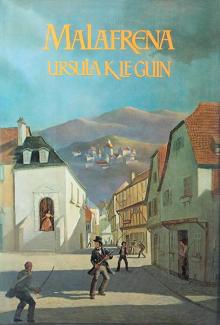 Malafrena
Malafrena The Lathe of Heaven
The Lathe of Heaven Five Ways to Forgiveness
Five Ways to Forgiveness The Eye of the Heron
The Eye of the Heron Four Ways to Forgiveness
Four Ways to Forgiveness Powers
Powers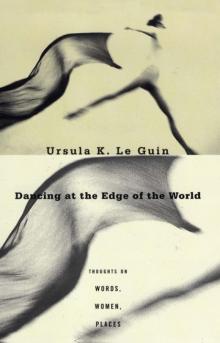 Dancing at the Edge of the World
Dancing at the Edge of the World Very Far Away from Anywhere Else
Very Far Away from Anywhere Else Voices aotws-2
Voices aotws-2 The New Atlantis
The New Atlantis The Unreal and the Real, Selected Stories of Ursula K. Le Guin Volume 1: Where on Earth
The Unreal and the Real, Selected Stories of Ursula K. Le Guin Volume 1: Where on Earth The Telling
The Telling Tehanu (Earthsea Cycle)
Tehanu (Earthsea Cycle) Nine Lives twtq-9
Nine Lives twtq-9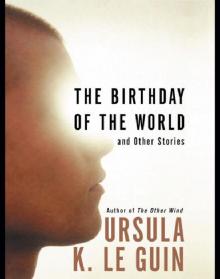 The Birthday of the World and Other Stories
The Birthday of the World and Other Stories The Dispossessed
The Dispossessed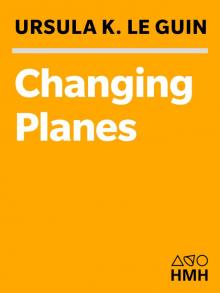 Changing Planes
Changing Planes Words Are My Matter
Words Are My Matter Powers aotws-3
Powers aotws-3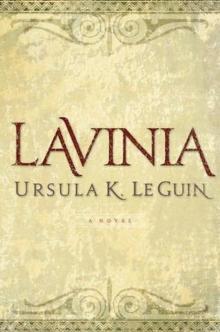 Lavinia
Lavinia The Wind's Twelve Quarters
The Wind's Twelve Quarters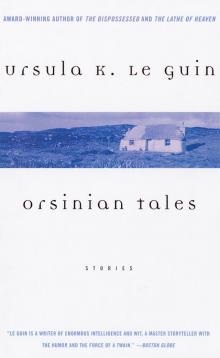 Orsinian Tales
Orsinian Tales Gifts aotws-1
Gifts aotws-1 Coming of Age in Karhide
Coming of Age in Karhide The Books of Earthsea: The Complete Illustrated Edition
The Books of Earthsea: The Complete Illustrated Edition The Found and the Lost
The Found and the Lost No Time to Spare
No Time to Spare Voices
Voices The Wild Girls
The Wild Girls Old Music and the Slave Women
Old Music and the Slave Women The Daughter of Odren
The Daughter of Odren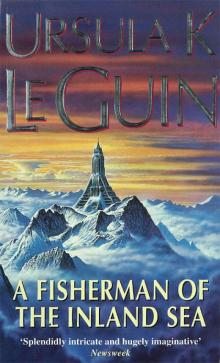 A Fisherman of the Inland Sea: Stories
A Fisherman of the Inland Sea: Stories A Wizard of Earthsea (The Earthsea Cycle)
A Wizard of Earthsea (The Earthsea Cycle) The Beginning Place
The Beginning Place The Left Hand of Darkness
The Left Hand of Darkness The Farthest Shore (Earthsea Cycle)
The Farthest Shore (Earthsea Cycle) The Matter of Seggri botw-2
The Matter of Seggri botw-2